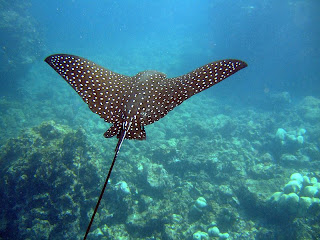October 6, 2011
At 6 in the morning, the sun is barely starting to emerge from the horizon and the first glimpse of pre-dawn allows the South Eleutheran landscape to escape from the grips of darkness. A strong northerly whips across Rock Sound and builds waves to a point where the wave break fails to provide any refuge from the whitecaps. This does not sound like ideal weather for an ocean swim. The rolling of the waves could make a dolphin seasick, while novice swimmers would be left choking on whitecaps cresting during a breath to windward. In other locations, this might result in a lost training day, or a dry-land workout, especially if the swimmers do not have access to an alternate site for training.
Luckily for The Island School, out in Cape Eleuthera, there is a man-made channel connecting the protected harbor and the adjacent waters of Rock Sound. The original intention of this narrow passage was to provide a release point for excess water that would surge into the marina during significant swells and storms. This concept has proven to be effective, most recently during Hurricane Irene in late August of 2011 when the storm surge battered the western entrance yet the surge did not submerge pilings farther into the marina. In this instance, water rose up nearly four feet, yet did not crest above the ridge along the sides.
Rock Sound is known for swift currents that manipulate ooid sandbars with such frequency that by the time the nautical chart has been printed, it has become obsolete. When that large amount of water is forced through an artificial passage it creates a torrent that rips downstream, pulling strands of sea grass out of their beds and forcing fish to swim furiously in order to maintain position.
Affectionately known as “The Cut” by Island School students and faculty, the channel is only two-tenths of a mile long, or a bit more than 350 yards, and provides a safe haven on windy or choppy days. Rather than being exposed to the raw elements of Rock Sound, we can train in a flat water, wind-free area. Factoring in the strong current against the swimmers, those 350 yards feel like a half-mile or even more. The water moving through the cut is deceptive. At one end, the only tell-tale signs are bubbles which have been stirred up as water moves over shallower areas sliding from right to left. On the marina side, eddies are visible when water moves past the support beams of the footbridge connecting Eleuthera to the island created when the cut was dug.
Different areas of the channel pose different hazards and challenges. Along the sides, although easier to navigate the current and make progress against land, sea urchins poke out from crevices in the limestone. Swimming right down the middle exposes you to the full brunt of the current. Simply put, there is no easy way to swim from one end to the other. Sheer heart and determination is the only way to forge ahead in the endless pursuit of the exit ramp on the other end.
Stroke by stroke and inch by inch, the goal of finishing one lap goes from impossible task to a certainty. Being tossed around from left to right actually helps move forward as the body gets pushed into an area of least resistance. Every once in a while, particularly around corners, one can find a nice back eddy. Swirling around points and curves in the cut allow for miniature vacuums to form, sucking water up to fill in. If you can find these magical pockets, it allows you to move effortlessly forward and is a huge confidence boost after being pounded back again and again. Upon reaching the Holy Grail of the exit ramp, an easy swim with the current is in store.
While on the way back to the starting point to pick up shoes, the sun finally pokes its rays out from behind the clouds which are already forming in the rainy season. Visibility in the water begins to rise and small fish, for which the cut acts as an estuary, flit about between mangrove roots. A few elementary backstroke pulls lowers the heart rate while also giving tired bodies a chance to bask in the warmth of a new day. There are no flip-turns and no lane lines, but this saltwater pool provides a great work out in a location that cannot be beaten.









